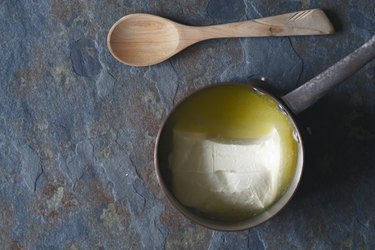
Light cream contains 18 to 29.9 percent milk fat, and gets added to sauces, soups, coffees and desserts to richen and sweeten the flavor. For those who don't prefer the taste or would rather look for healthier alternatives, finding a light cream substitute will not take much effort.
Tip
If you don’t have light cream, you could use coconut cream, 2 percent milk or evaporated milk. You can also add butter and milk to these ingredients to mirror the taste of light cream.
Video of the Day
Light Cream Substitute
Light cream, also known as single cream, is heavier than half-and-half (used often to make ice cream and in pasta sauces) and lighter than whipping cream (used often on top of hot chocolate or sundaes). The single cream definition, according to the International Dairy Foods Association (IDFA), is cream containing 18 to under 30 percent milk fat.
Video of the Day
Light cream contains 30 calories per tablespoon per the USDA. Because of the lack of fatty solids, light cream can't get whipped and lacks the full-bodied flavor of heavy whipping cream (that contains 36 to 40 percent milk fat and 51 calories per tablespoon, per the USDA).
For those wanting a single cream alternative, whether for flavor or health, creams are one of the most versatile ingredients, giving you options. These include six of the following you can test:
- Use full-fat coconut cream. This substitute works for the vegan or dairy
intolerant. However, this cream does contain a coconut flavor and won't work in all dishes.
Coconut cream won't cause any detrimental effect to your lipid fats and can
even support heart health, according to an April 2016 study from Nutrition Reviews.
- Substitute with 2 percent milk. You shouldn't worry about drinking the 2 percent milk, despite public skepticism. According to a November 2016 assessment published in Food & Nutrition Research, based on available scientific evidence, consuming milk can prevent chronic diseases and has few adverse effects.
In baking, you can probably get away with using 2 percent milk, although sauces and desserts will taste better with a higher fat product. You should note that dairy products are prone to curdling when heated at high temperatures. The lower the fat content, the more likely the product is to curdle and separate. Use a thickener, such as cornstarch mixed with cold water, if a sauce isn't thick enough due to using a lower-fat dairy product. Cornstarch slowing whisked into an almost simmering sauce can also help prevent or fix curdling. - Pour in half-and-half cream. According to the USDA, this product contains 3 grams of total lipid fats and 40 calories
per 2 tablespoons, and will not taste quite as rich as light cream.
- Stir in canned evaporated milk. According to the IDFA, evaporated milk has been heated
to remove 60 percent of the water in the milk, creating a thick, creamy product
relatively low in calories while high in nutrients. For baking, combine 3
tablespoons melted butter with a slight dash of milk. The fat in the butter
mimics the fat in light cream to tenderize baked dessert goods and add flavor.
- Mix in powdered coffee creamer. Although this will work in hot coffee, coffee creamer
products generally won't work in baked goods.
- Puree tofu. According to godairyfree.org, an organization dedicated to dairy-free diet enthusiasts, you can switch light cream with pureed tofu using a 1 to 1 ratio for a lower fat choice.
- United States Department of Agriculture: “Light Cream”
- United States Department of Agriculture: “Cream, Fluid, Heavy Whipping”
- United States Department of Agriculture: “Half and Half Cream”
- Nutrition Reviews: “Coconut Oil Consumption and Cardiovascular Risk Factors in Humans”
- International Dairy Foods Association: “Definitions”
- Food & Nutrition Research: “Milk and Dairy Products: Good or Bad for Human Health? An Assessment of the Totality of Scientific Evidence”
- Godairyfree.org: “How to Substitute Cream”